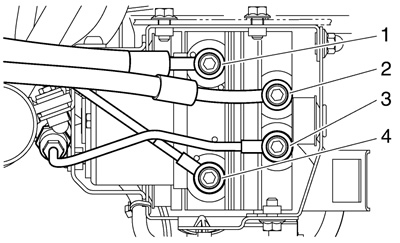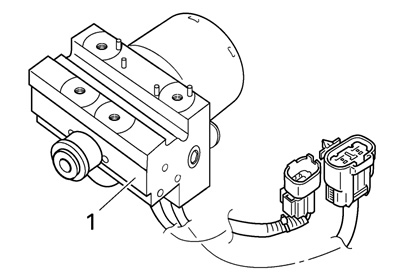Caution! Do not turn the crankshaft when installing the camshaft sprockets to avoid damage or improper valve.

Warning! Refill with the same type of brake fluid that is already in the system. Mixing fluids may result in a harmful chemical reaction, leading to poor braking performance.
Cautions!
- Handle the ABS components with care since they have been accurately adjusted. Keep them away from dirt and do not subject them to shocks.
- The ABS wheel sensor cannot be disassembled. Do not attempt to disassemble it. If faulty, replace with a new one.
- Do not turn the main switch to «ON» when removing the hydraulic unit.
- Do not clean with compressed air.
- Do not use reuse the brake fluid.
- Brake fluid may damage painted surfaces and plastic parts. Therefore, always clean up any spilt brake fluid immediately.
- Do not allow any brake fluid to contact the couplers. Brake fluid may damage the couplers and cause bad contacts.
- If the union bolts for the hydraulic unit have been removed, be sure to tighten them to the specified torque and bleed the brake system.
Removing the hydraulic unit
1. Remove:
- Brake hose «1» (from the front brake master cylinder)
- Brake hose «2» (to the front brake caliper)
- Brake hose «3» (to the rear brake caliper)
- Brake hose «4» (from the rear brake master cylinder)

Note: Do not operate the brake lever and brake pedal while removing the brake hoses.
Caution! When removing the brake hoses, cover the area around the hydraulic unit to catch any spilt brake fluid. Do not allow the brake fluid to contact other parts.
2. Remove:
- Hydraulic unit bracket
Note: Loosen the bolt in the proper sequence.
3. Remove:
- Hydraulic unit «1»
Note: To avoid brake fluid leakage and to prevent foreign materials from entering the hydraulic unit, insert a rubber plug «a» or a bolt (M10x1.25) into each union bolt hole.

Checking the hydraulic unit
1. Check:
- Hydraulic unit «1»
Cracks/damage → Replace the hydraulic unit.

Installing the hydraulic unit
Proceed in the reverse order of disassembly.
Pay attention to the following items.
1. Install:
- Hydraulic unit bracket
Hydraulic unit bracket bolt: 10 Nm (1.0 m·kg, 7.2 ft·lb).
Note: Tighten the nuts in the proper sequence.
2. Install:
- Hydraulic unit
Note: Do not allow any foreign materials to enter the hydraulic unit or the brake hoses when installing the hydraulic unit.
Caution! When installing the fuel hose, make sure that it is securely connected, and that the fuel hose holders are in the correct position, otherwise the fuel hose will not be properly installed.
3. Remove:
- Rubber plugs or bolts (M10x1.25)
4. Install:
- Copper washer
- Brake hose «1» (to the rear brake caliper)
- Brake hose «2» (from the rear brake master cylinder)
- Brake hose «3» (to the front brake caliper)
- Brake hose «4» (from the front brake master cylinder)
- Union bolt
Brake hose union bolt: 30 Nm (3.0 m·kg, 22 ft·lb).

Warning! The brake hoses to the front and rear brake calipers can be distinguished by the rubber at the end of each hose. Be sure to connect each brake hose to the correct union bolt hole.
Caution! To route the front and rear brake hoses, refer to «Cable routing».
5. Fill:
- Brake master cylinder reservoir
Recommended brake fluid: DOT 4.
6. Bleed the brake system.
7. Check the operation of the hydraulic unit according to the brake lever and the brake pedal response. (Refer to «Hydraulic unit operation test»).
Caution! Always check the operation of the hydraulic unit according to the brake lever and the brake pedal response.
8. Delete the malfunction codes. (Refer to «[D-6-4] Deleting the malfunction code»).
9. Perform a trial run. (Refer to «Trial run»).
